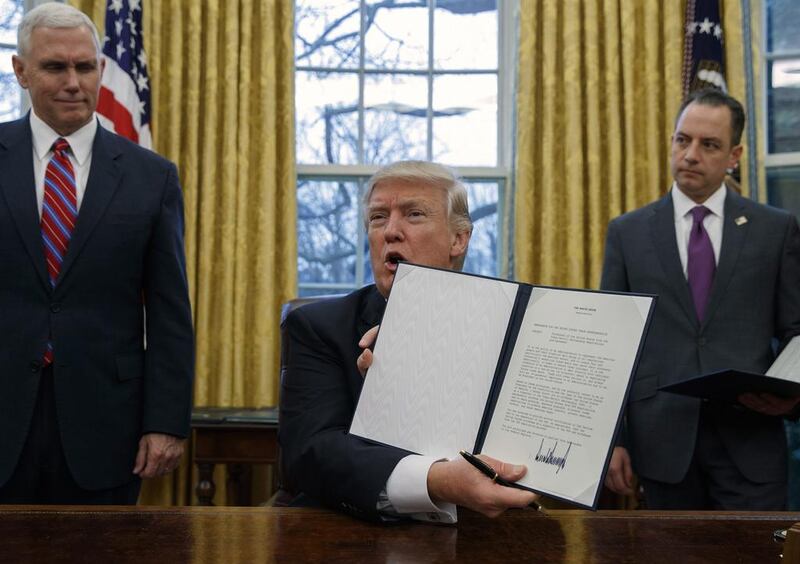Sometimes electoral promises tend to remain just that – promises.
It appears Donald Trump is keen to keep his word.
His first weeks at the helm of the United States have certainly demonstrated an intent to turn campaign messages into political reality. With trade a signature issue, odds are high that protectionist measures will be enacted, beyond the already announced withdrawal from the Trans-Pacific Partnership (TPP).
How tough a stance the new US administration takes on trade will shape not only growth during the next few years – global recession being a definite risk – but also the longer-term world order. The time may have come to reappraise trade relations with markets long considered closed.
Since Adam Smith first extolled the virtues of free trade back in 1776, few economists have questioned its benefits. The great John Maynard Keynes himself, albeit having argued for tariffs in 1931 to help Britain recover from the Great Depression, was steadfast in the view that free trade is the best policy for economic growth in the long run. The American scholar Richard Epstein wrote last year in a paper (published – somewhat ironically as will transpire below – by the Hoover Institution): “The simple but powerful truth [is] that overall levels of profitability and wealth increase under free trade. The short-term relief that targeted groups get from protectionist measures mask the larger inefficiencies that slow down the rate of growth”.
Why then such wrath against globalisation across western countries? To begin with, free trade is one concept, fair trade quite another. Even in the heyday of global commerce, covert protectionism never really ceased. More importantly though, the populist backlash on both sides of the Atlantic stems not from globalisation per se, but from the uneven distribution of its benefits. Middle-classes did not share the wealth created during the post-Cold War period. In fact, they saw their living standards drop and job insecurity increase.
Mass deportation of Mexican Americans, higher import duties to protect domestic jobs and farmers are measures actually date back to 1929-1933. In June 1930, the US president Herbert Hoover signed into law the Smoot-Hawley Tariff Act, despite veto urges by economists and executives (the JP Morgan partner Thomas Lamont is said to have nearly dropped to his knees), threats of retaliatory actions by many trading partners and his own misgivings about undermining international cooperation. Retaliation, led by Canada, did occur. US imports and exports dropped by more than 60 per cent between 1929 and 1932 – only serving to worsen the effects of the Great Depression on US workers and farmers. By 1933, two thirds of global trade had evaporated.
Coming back to the present day, what do we know about Mr Trump and trade? We know that the new president and his entourage consider free trade agreements as job-killers. We know that China, with whom the US runs by far its largest bilateral trade deficit (at near US$350 billion in 2015), has been explicitly targeted – with Mexico next in line. And we know that trade is an issue on which existing legislation gives the Mr Trump substantial room for action.
Should a full-on trade war be engaged, with China and Mexico responding tit for tat to US-imposed tariffs, the direct impact on the US economy would be large enough to cause a recession – even before accounting for supply chain disruptions. Real-world manufacturing is a far cry from textbook theory. And the relationship between importers and exporters is not a simple one. Components often cross borders multiple times before a final product reaches the consumer. Consider just the journey that a modern US car seat belt undertakes; manufactured in Mexico, woven and dyed in Canada, cut and sewed back in Mexico and finally installed in the US. Another case in point is the Boeing 787. An emblem of US manufacturing prowess? Certainly, but its components happen to be sourced from all over the world.
Outside the US, the economic impact is also likely to be huge. Were US protectionist measures to “succeed” in closing the long-time trade deficit, the dollar would undoubtedly appreciate, tightening financial conditions across the globe. For emerging markets the immediate whammy would be double: higher servicing costs on their huge dollar-denominated debt at a time of shrinking exports to the US. Worse, the dollar’s very role as the world reserve currency could be called into question.
It is precisely because an Obama-led US was intent on bolstering its own leadership in Asia that China found itself excluded from the multi-year TPP negotiations. After Mr Trump reneged on this pact, Chinese leaders were not long in reactivating talks on the Asian regional trade deals that they support.
The recent World Economic Forum also offered China’s president Xi Jinping a great stage to criticise (western) protectionist tendencies, likening them to “locking oneself in a dark room”.
China meanwhile is opening up – and faster than most care to acknowledge. Last October, its currency officially joined the US dollar, euro, yen and British pound in the IMF’s special drawing rights basket. The yuan may not yet be freely usable, nor widely traded on financial markets, but it is on its way to gaining reserve currency status.
Mr Trump’s surprise win and promise of trade barriers has sent some investors running for the hills in emerging markets but, at Lombard Odier, we are staying put.
Our conviction that China’s developments will significantly impact the emerging bloc at large keeps us structurally overweight. With its industrial demand benefiting the likes of Brazil and Russia, as well as trade across the Pacific Rim, China is arguably the link that ties together all emerging economies.
Alongside Beijing’s multibillion investment to resurrect the ancient Silk Road to the Middle East and Europe (now termed “One Belt, One Road”), this could indeed enormously alter the world order as we know it.
Samy Chaar is the chief economist at the Swiss private bank Lombard Odier.
business@thenational.ae
Follow The National's Business section on Twitter





